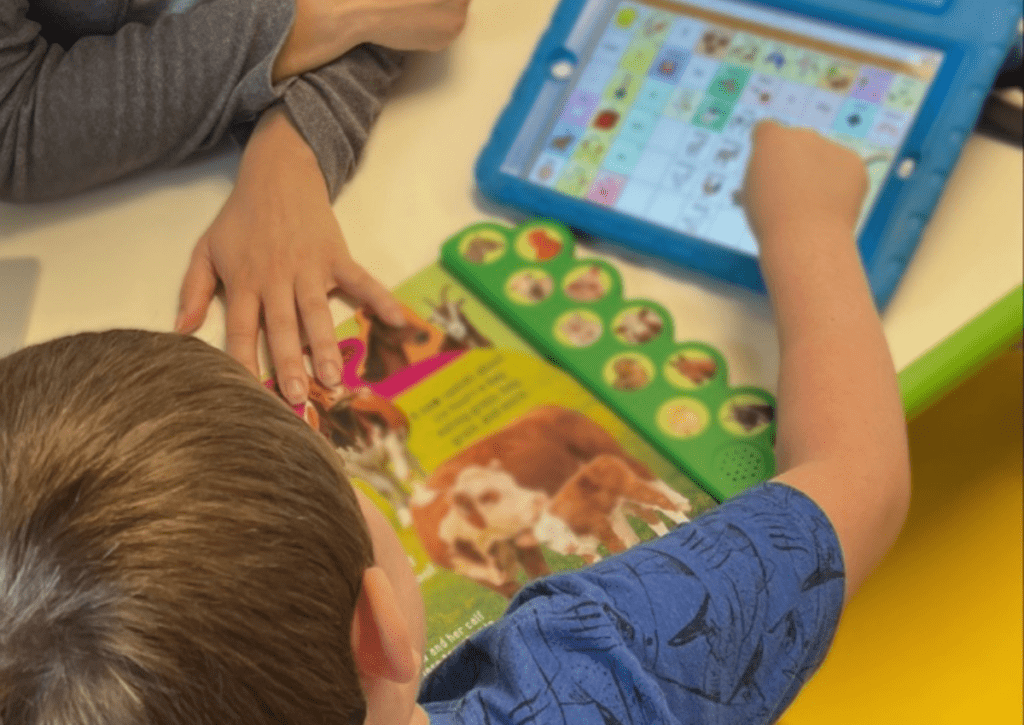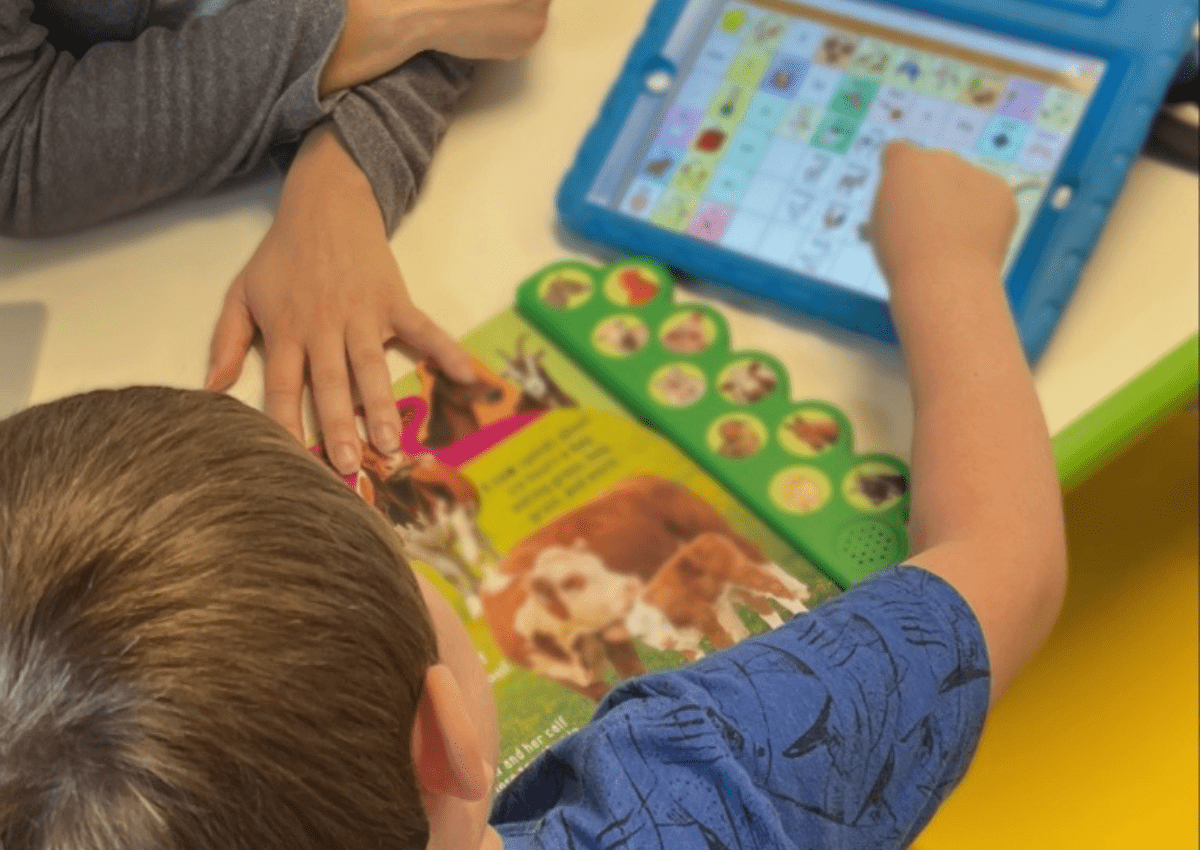
There are many means of communication used in our world. The most common ones used today are spoken words, gestures, eye gaze, facial expressions, print, sign language, and even GIFs. When it comes to individuals with speech and language delays, it is possible to augment and provide alternative options for them to efficiently communicate with others. Children with autism, Down syndrome, and other speech and language struggles benefit from access to additional communication tools. In this post we will explain what AAC is and why it’s important for children with autism.
AAC stands for Augmented Alternative Communication. What does augmentative mean, you might be wondering? Augmentative simply means to make something greater by adding to it, and alternative, as we know, is to have multiple options or possibilities available in a situation. So, when thought about it in literal terms, AAC is something every person uses to communicate.
Types of AAC
There are two different types of AAC. The first type is what most people use in addition to or instead of verbal communication, which includes some of the examples we listed above. However, many children (and adults) with an autism diagnosis utilize aided AAC, which can be “high tech” or “low tech”. Low tech AAC can be anything that involves using pictures or icons to communicate. High tech describes communication apps on an iPad or tablet, such as TouchChat or LAMP Words for Life. Any type of computer with a voice, or even large buttons that talk, would also be considered high-tech AAC.
Myths Surrounding AAC
When it comes to AAC, many people, including parents and professionals, are misled by the myths that have historically surrounded it. The most common myth is that AAC will hinder speech development. While this may seem easily believable, we have seen many examples in our clinic and elsewhere of children who build more speech due to having another opportunity as a bridge to spoken language.
Another popular myth regarding AAC is that it’s not necessary so long as the child or person can communicate their basic wants and needs. At Healing Haven, we support not just the very basics of communication, but each individual’s growth and independence. This means making friends, expressing ideas, showing interest in hobbies and activities, showing love, and much more. Everyone deserves the opportunity to do these things.
Effective Use of AAC
While AAC, whether high tech or low tech, is a bountiful means of communication, there are reasons it may not be effective, which can be discouraging to families.
AAC is most successful when parents, caregivers, and school staff have been educated to personalize the device and present models appropriately. Presenting models “appropriately” may look different for different children based on their language level, processing time and interests. When these factors are not taken into account, ineffectiveness and inefficiency can result.
It is important that families who are adjusting to a new form of AAC have the resources and support they need to effectively integrate the form of communication into their child’s life. At Healing Haven, this is a large part of the parent training we offer to each individual and their family.
Teaching AAC with Spoken Word Communication
One must remember that AAC is just another avenue to communication for those with language and speech processing challenges. The autistic community themselves say they need more than one avenue to communicate. Many times, speech and language professionals teach an individual AAC and spoken word communication simultaneously. Through the therapy we provide at our clinic, the two will always go hand in hand. It is important to us that every child has more than one option in their modes of communication.
It is important to understand your child’s style of language processing to personalize the vocabulary and provide appropriate models. Please reference the “User Tips for AAC” section below to learn more and see the link to our blog detailing Analytical Language Processing and Gestalt Language Processing. The Speech and Language Pathologists at our clinic are highly skilled in helping parents and children personalize AAC based on the child’s style of language processing.
Setting Your Child Up for Success with their AAC Device
There are many steps you can take to ensure your child with autism has a pleasant and successful AAC experience. While some of these may be easily overlooked, they are vital in encouraging and teaching your child to communicate. Some of these steps are:
- Ensure the AAC device is always readily available. This includes having necessary AAC accessories such as cases with handles and straps.
- Learn how to edit and add new content to your child’s AAC device.
- Allow your child to explore the device as much as they please. Even if it seems like the child is just playing or “stimming” with the device, this interaction is still helping to familiarize the child with the AAC and its functions.
- Model consistently and often on the AAC device.
- Ensure everyone involved with helping your child communicate (family members, school staff, caregivers, etc.) knows how to effectively and comfortably model language on the device. This includes knowing and educating yourself on your child’s style of language processing.
- Do as much as you can to encourage your child’s use of the device. This could look like modeling on the device to talk about your child’s favorite cartoon character, food, or activity, or creating communication opportunities that are appealing to your child and their interest.
- Always ask your child’s SLP for help when needed. These individuals are AAC experts and should be able to help with whatever you may need to be as fluent as possible with AAC communication! At our clinic, the SLPs and BCBAS collaborate and work seamlessly to support the child’s communication. You have a team of resources.
- Lastly, ensure the form of AAC is consistent across all professionals and/or providers (the child’s entire team should be using the same type and same brand of high or low tech AAC).
User Tips for AAC
When it comes to children with speech-language deficits, communication is most effective when it is used naturally. With that, we encourage you to follow your child’s lead with their communication attempts and always react with praise at any attempt they make to communicate. It is best to simply model alternative ways to communicate, as opposed to requiring a response from your child before giving them what they want.
Many children with autism are Gestalt Language Processors (GLPs). For GLPs, there are four stages of language development. What stage your child is at determines the setup of their AAC device. If your child is at a stage 3 or higher, or once they get to that point, they are working on the freeing of single words and the combining of 2-3 words. This is where it’s important to know the difference between core vocabulary and fringe words.
Many AAC devices have a core board, which is a page on the device, typically the main page when opening the app, that includes both “core” words and phrases and “fringe” words. The exact configuration of these words depends on the device and app being used. You can then use these words and phrases to help your child build their vocabulary and customize it to fit their wants and needs. Alternatively, if your child uses lower-tech AAC, such as Picture Exchange Communication System (PECS), you and your child’s speech team can customize the words based off of the child’s interests and needs.
AAC Resources
If your child has an assigned Speech Language Pathologist, they will be your best AAC resource. Additionally, the internet is abundant with resources that can help you navigate and utilize your child’s AAC device. Here are some of the top websites we recommend to parents of AAC users:
And of course, learn more about AAC by connecting with our speech team at Healing Haven, operated by Gigi’s Kids Speech and Language Therapy, which the information in this post comes from.
We hope this post has helped enrich your knowledge of AAC and answered some questions you may have had surrounding it. If your child has benefited from the use of AAC, please feel free to share in the comments. Let’s continue to make communication all-inclusive!

